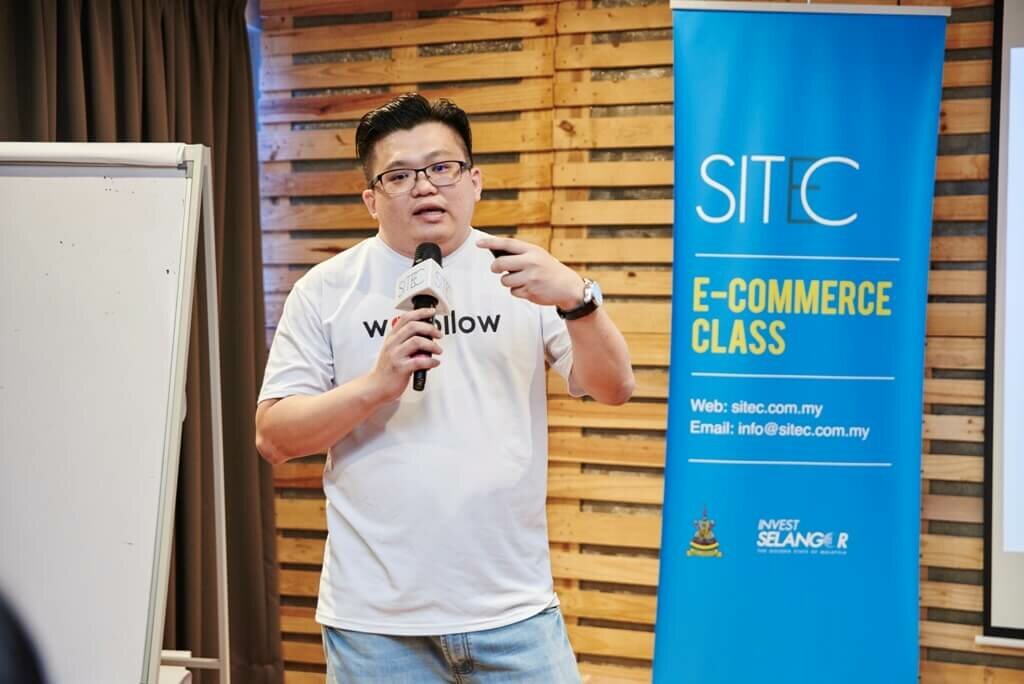O2O leads customers to your doorstep

GARY BOON, WOFOLLOW
Gary (pictured, above) began with a Q&A session to remind the attendees that regardless of whether a store is online or offline, the most important thing within business are the “three streams”, namely “information flow, cash flow and logistics”. O2O helps businesses explore customers and also to save costs. Online customer traffic, transaction data, and so on, accumulated over the years, allows businesses to understand consumers and predict sales through analytics and continually develop new customers and reach out to existing customers. “You cannot sell a shampoo to a bald person unless he wants to buy it for other friends.” Fang says that online marketing can help you get the most out of your customers.
Gary shared his own 8 O2O models, namely, group buy, classified directory, social media CRM, review site, two-line retail, booking app, cash back and mobile e-coupons. Groupon is known as the group purchase model. Classified directory sites such as Mudah, Carlist, iProperty, etc. can be seen as “online yellow pages”, allowing users to get your contact information online for offline transactions.
Gary also encourages businesses to use social media, such as WeChat or Facebook and other communications features to send coupons to customers. If it’s a restaurant, business owners can join review sites such as Open Rice to get more exposure. Accumulation of good reviews from customers will increase the store’s reputation, and create a cycle of steady business.
Retailers will also be able to shop the stores online & offline at their preference, while restaurant operators can extend non-peak hours via booking apps to increase revenue and save costs. The industry can also partner with card companies such as Cardpow, Manis or banks that enables customers to accumulate spending points for cash return- these are some of the ways that help attract repeat customers.
Wofollow helps businesses to gain more exposure by registering and using their platform for free. By uploading e-coupons, merchants are able to track the user behaviour of the coupons and their background information. Customers no longer need to receive paper coupons as mobile e-coupons platforms like Wofollow, streamline the deal-finding process for consumers.
Customers are impatient in the era of O2O
The co-founder of ‘O2O Commerce’, Teow Han Ming, called strongly upon merchants to keep up with the unavoidable and fast growing trend of Online to Offline Businesses.
The O2O business model evolved from e-commerce that combines offline business opportunities with the Internet. By attracting customers online, the real consumption of service is experienced offline. Smartphone ownership is ubiquitous these days, and getting online is incredibly easier now than before. With this uptake, though, comes increased customer expectations, however. “If customers want to find you, but have to wait till next minute or the next day, your business is finished!”, quipped Han (pictured, below)

For the company ‘O2O Commerce’ itself, they work with traditional industries, by adopting their WiFi programs to enhance the number of store visits. When the user’s mobile phone connected to the O2O Commerce’s WiFi network, they will receive push notifications informing of nearby promos. Meanwhile, businesses can check the store’s daily customer traffic, their background and so on. O2O Commerce will also provide analysis of how stores can improve their operations, such as special offers for specific groups of customers. In the future, O2O Commerce will expand its business to Southeast Asia, enabling travellers from all over the world to take advantage of O2O to get the best service and experience.
Taking care of furkids can be O2O
Petsodia is an online platform that connects and finds a sweet home for pets when the owner is away. Its co-founder Patrick Chang mentioned that Southeast Asia’s pet industry output value in 2014 is at least 1.4 billion US dollars, and most of them are from pet food sales. As for the global pet industry, it recorded 30% growth per year. This phenomenon highlights a growing middle class. “Previously cats and dogs eat kitchen waste, but now they eat animal food. Cats and dogs in the city gradually become the human’s best friend. ”
The concept of Petsodia comes from Patrick’s previous experience of having to travel frequently, which involved getting professional pet sitters for his beloved furkids.

Patrick Chang, Petsodia
According to Patrick, friends or relatives usually are not the ideal people to take care of pets due to lack of experience. However, the other alternative of sending to a pet shop/hotel would mean somewhat better care, although their furkids would have to be caged.
Enter the family pet sitter service, which are run by pet owners and lovers, who can pet sit other peoples’ pets like they are taking care of their own at a price. At that point in time, information regarding such services were inaccessible and scattered, so he decided to set up a platform to link pet owners with pet sitters. Pet owners choose and send in their request online, then bringing their pet to meet the host offline. This in a way achieve an alternative O2O service.
When comes to O2O operations, Patrick advised not to assume that O2O can solve all the problems. Base on the business nature, different business will have various degrees of O2O integration. Business owners has to understand their own business and knowing what are the O2O solution and how many they should adopt. They also need to interact closely with the solution provider to produce the best outcome. At the end of it, customer’s demand of products and services are still the main concern to businesses.
The final part of the event is market info sharing session. Alice Foong, the COO of CheQQme came to introduce their O2O solution, which is a mobile marketing platform. This followed by Allan Kuah, who is a lawyer to explain about several common legal issues and disputes in e-commerce.

![ECC 16 [2016] – O2O bridges gap between online and offline businesses](https://www.sitec.com.my/wp-content/uploads/2016/12/image003-1024x675.jpg)